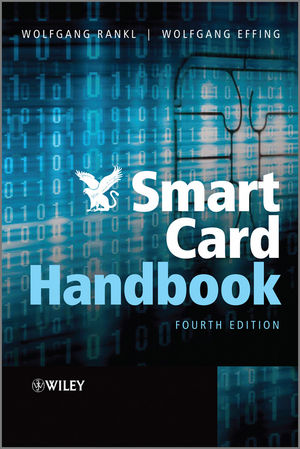Smart Card Handbook, 4th EditionISBN: 978-0-470-74367-6
Hardcover
1088 pages
July 2010
 This is a Print-on-Demand title. It will be printed specifically to fill your order. Please allow an additional 15-20 days delivery time. The book is not returnable.
|
||||||
Symbols and Notation.
Abbreviations.
1 Introduction.
1.1 The history of smart cards.
1.2 Card types and applications.
1.3 Standardization.
2 Card Types.
2.1 Embossed cards.
2.2 Magnetic-stripe cards.
2.3 Smart cards.
2.4 Optical memory cards.
3 Physical Properties.
3.1 Card formats.
3.2 Contact field.
3.3 Card body.
3.4 Card materials.
3.5 Card components and security features.
3.6 Chip modules.
4 Electrical Properties.
4.1 Electrical connections.
4.2 Supply voltage.
4.3 Supply current.
4.4 Clock supply.
4.5 Data transmission with T = 0 or T =1.
4.6 Activation and deactivation sequences.
5 Smart Card Microcontrollers.
5.1 Semiconductor technology.
5.2 Processor types.
5.3 Memory types.
5.4 Supplementary hardware.
5.5 Extended temperature range.
6 Information Technology Foundations.
6.1 Data structures.
6.2 Encoding alphanumeric data.
6.3 SDL notation.
6.4 State machines.
6.5 Error detection and correction codes.
6.6 Data compression.
7 Security Foundations.
7.1 Cryptology.
7.2 Hash functions.
7.3 Random numbers.
7.4 Authentication.
7.5 Digital signatures.
7.6 Certificates.
7.7 Key management.
7.8 Identification of persons.
8 Communication with Smart Cards.
8.1 Answer to reset (ATR).
8.2 Protocol Parameter Selection (PPS).
8.3 Message structure: APDUS.
8.4 Secure Data Transmission.
8.5 Logical channels.
8.6 Logical protocols.
8.7 Connecting terminals to higher-level systems.
9 Data Transmission with Contact Cards.
9.1 Physical transmission layer.
9.2 Memory card protocols.
9.3 ISO transmission protocols.
9.4 USB transmission protocol.
9.5 MMC transmission protocol.
9.6 Single-wire protocol (SWP).
10 Contactless Data Transmission.
10.1 Inductive coupling.
10.2 Power transmission.
10.3 Data transmission.
10.4 Capacitive coupling.
10.5 Collision avoidance.
10.6 State of standardization.
10.7 Close-coupling cards (ISO/IEC 10536).
10.8 Remote coupling cards.
10.9 Proximity cards (ISO/IEC 14443).
10.10 Vicinity integrated circuit cards (ISO/IEC 15693).
10.11 Near field communication (NFC).
10.12 FeliCa.
10.13 Mifare.
11 Smart Card Commands.
11.1 File selection commands.
11.2 Read and write commands.
11.3 Search commands.
11.4 File operation commands.
11.5 Commands for authenticating persons.
11.6 Commands for authenticating devices.
11.7 Commands for cryptographic algorithms.
11.8 File management commands.
11.9 Application management commands.
11.10 Completion commands.
11.11 Commands for hardware testing.
11.12 Commands for data transmission.
11.13 Database commands (SCQL).
11.14 Commands for electronic purses.
11.15 Commands for credit and debit cards.
11.16 Application-specific commands.
11.17 Command processing times.
12 Smart Card File Management.
12.1 File structure.
12.2 The life cycle of files.
12.3 File types.
12.4 Application files.
12.5 File names.
12.6 File selection.
12.7 EF file structures.
12.8 File access conditions.
12.9 File attributes.
13 Smart Card Operating Systems.
13.1 Evolution of smart card operating systems.
13.2 Fundamental aspects and tasks.
13.3 Command processing.
13.4 Design and implementation principles.
13.5 Operating system completion.
13.6 Memory organization and memory management.
13.7 File management.
13.8 Sequence control.
13.9 ISO/IEC 7816-9 resource access.
13.10 Atomic operations.
13.11 Multitasking.
13.12 Performance.
13.13 Application management with global platform.
13.14 Downloadable program code.
13.15 Executable native code.
13.16 Open platforms.
13.17 The small-OS smart card operating system.
14 Smart Card Production.
14.1 Tasks and roles in the production process.
14.2 The smart card life cycle.
14.3 Chip and module production.
14.4 Card Body production.
14.5 Combining the card body and the chip.
14.6 Electrical testing of modules.
14.7 Loading static data.
14.8 Loading individual data.
14.9 Envelope stuffing and dispatching.
14.10 Special types of production.
14.11 Termination of card usage.
15 Quality Assurance.
15.1 Card body tests.
15.2 Microcontroller hardware tests.
15.3 Test methods for contactless smart cards.
15.5 Evaluation of hardware and software.
16 Smart Card Security.
16.1 Classification of attacks and attackers.
16.2 A history of attacks.
16.3 Attacks and defense measures during development.
16.4 Attacks and defense measures during production.
16.5 Attacks and defense measures during card usage.
17 Smart Card Terminals.
17.1 Mechanical properties.
17.2 Electrical properties.
17.3 User interface.
17.4 Application interface.
17.5 Security.
18 Smart Cards in Payment Systems.
18.1 Payment transactions with cards.
18.2 Prepaid memory cards.
18.3 Electronic purses.
18.4 EMV Application.
18.5 PayPass and payWave.
18.6 The Eurocheque System in Germany.
19 Smart Cards in Telecommunication Systems.
19.1 Public card phones in Germany.
19.2 Telecommunication.
19.3 Overview of mobile telecommunication systems.
19.4 The GSM system.
19.5 The UMTS system.
19.6 The wireless identification module (WIM).
19.7 Microbrowsers.
20 Smart Cards in Health Care Systems.
20.1 Health insurance cards in Germany.
20.2 Electronic health care cards in Germany.
21 Smart Cards in Transportation Systems.
21.1 Electronic tickets.
21.2 Ski Passes.
21.3 Tachosmart.
21.4 Electronic toll systems.
22 Smart Cards for Identification and Passports.
22.1 FINEID personal ID card.
22.2 ICAO-compliant passports.
23 Smart Cards for IT Security.
23.1 Digital signatures.
23.2 Signature applications compliant with PKCS #15.
23.3 Smart Card Web Server (SCWS).
24 Application Design.
24.1 General information and characteristic data.
24.2 Application generation tools.
24.3 Analyzing an unknown smart card.
25 Appendix.
25.1 Glossary.
25.2 Related reading.
25.3 Bibliography.
25.4 Directory of standards and specifications.
25.5 Web addresses.
Index.



